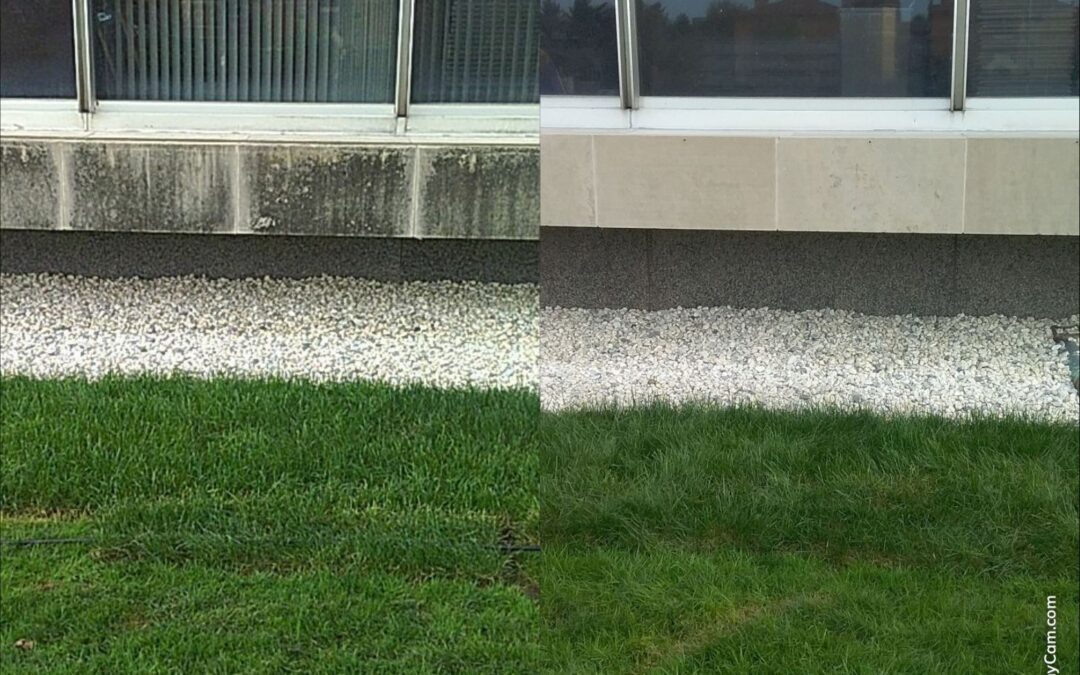Cleaning and sealing exterior stone surfaces is crucial as they often accumulate dirt and stains over time, resulting in dark streaks and discoloration. While preventing this entirely can be challenging, understanding and addressing the primary causes of staining can significantly reduce buildup. Here are common causes of stone staining and potential damage they can cause, along with the benefits of cleaning and sealing exterior surfaces.
Combatting Carbon-Based Pollution on Exterior Stone
To begin with, vehicle exhaust is a significant source of carbon-based pollutants that seep into exterior stone pores, fostering bacteria growth that results in black stains. This discoloration is especially noticeable on softer, more porous stones like limestone, particularly around protruding features such as cornices and copings.
This bacterial growth can deteriorate the exterior stone if untreated. Therefore, regular cleaning and sealing prevent bacteria from taking hold, preserving the building’s appearance and structural integrity.
Addressing Biological and Plant Growth
Algae and moss thrive on moisture trapped within exterior stone surfaces, typically found on lower sections of walls and shaded areas. Moreover, ivy and similar plants pose a significant threat to historic structures by creating pathways for moisture to penetrate the building, leading to structural issues. Thus, prompt removal and sealing of the stone can prevent these problems and protect the structure’s integrity.
Managing Efflorescence
Additionally, efflorescence is the appearance of mineral or salt deposits on stone surfaces due to moisture evaporation. This can appear in various colors and reoccur if the underlying moisture problem is not addressed. As a result, cleaning, sealing, and investigating moisture sources are essential to managing this issue.
Dealing with Freeze-thaw Damage
In colder climates, moisture trapped by dirt can freeze and expand, causing cracks and spalling in masonry and concrete. This cyclical freeze-thaw process can gradually compromise the structural integrity of exterior surfaces. Therefore, cleaning and sealing facades creates a protective barrier that repels moisture.
Preventing Metallic Stains
Lastly, metallic stains can arise from minerals within the exterior stone or iron used in construction. Historic buildings with copper architectural elements may develop green streaks from oxidation. Consequently, regular cleaning and sealing help prevent these stains and maintain the building’s aesthetic appeal.
Benefits of Cleaning and Sealing Exterior Stone Surfaces
Regular maintenance through cleaning and sealing offers numerous benefits:
- Enhanced Appearance: Keeps the building looking clean and attractive.
- Structural Preservation: Prevents bacterial growth, moisture infiltration, and plant root expansion.
- Increased Longevity: Extends the stone’s life, reducing the need for costly repairs or replacements.
- Protection: Acts as a barrier against pollutants, moisture, and biological growth, enhancing durability.
- Boost Tenant or Customer Satisfaction: Creates a welcoming and professional appearance.
Maintaining and protecting exterior surfaces is essential for both aesthetic and structural reasons. By proactively managing dirt and staining, building owners can help preserve structural integrity, extend the lifespan of their structures, and avoid costly repairs associated with long-term neglect. Contact our team today for a thorough evaluation of your facade. With our help, your building will remain beautiful, and well maintained for years to come.

